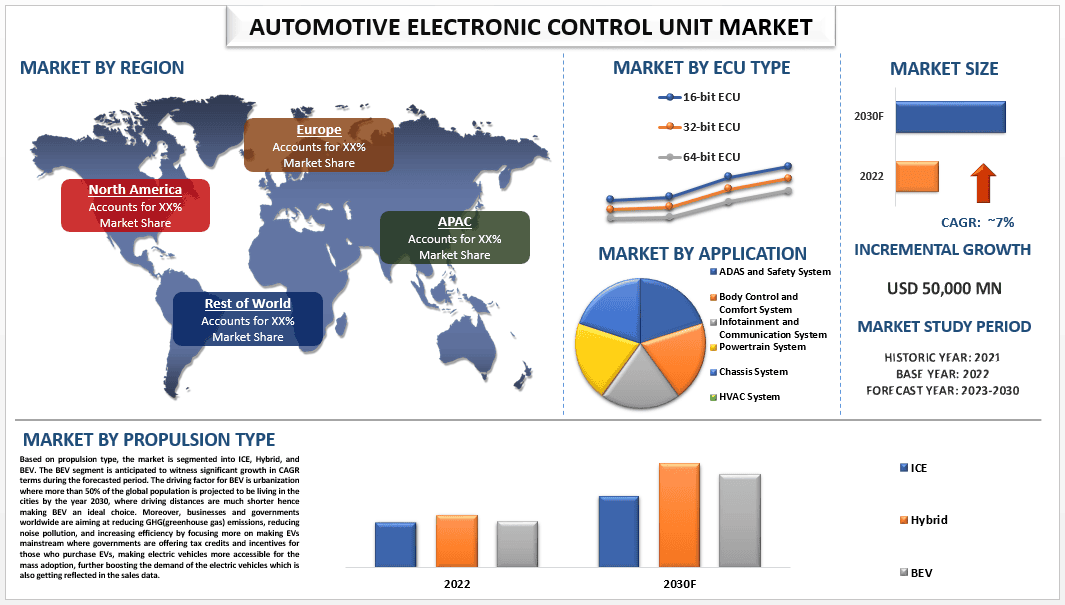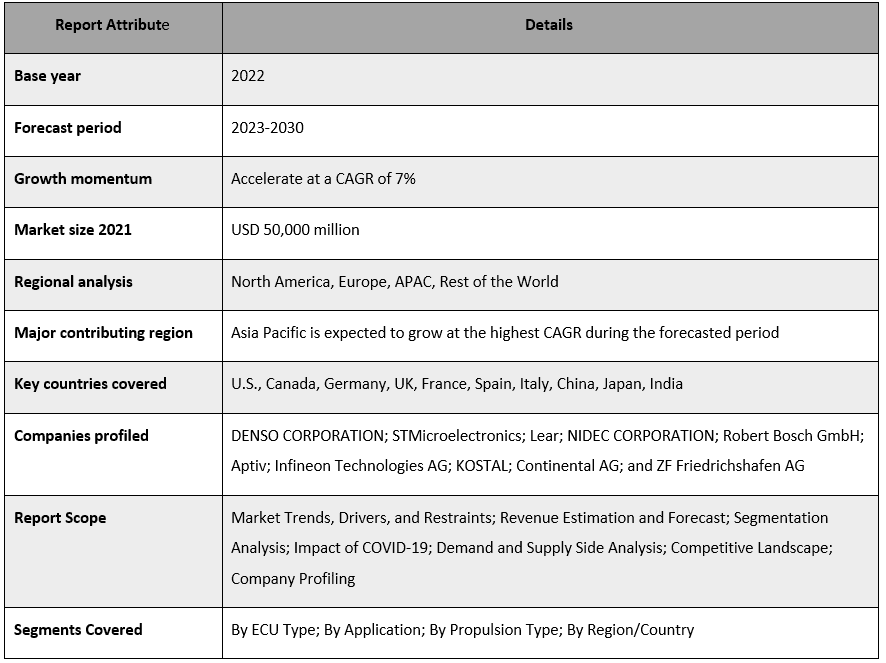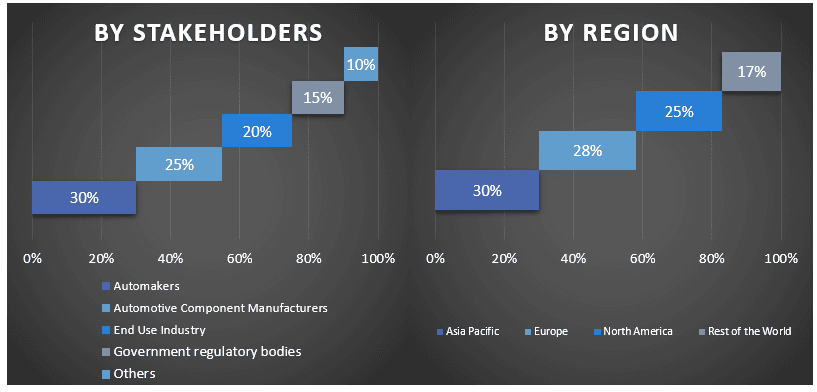- Home
- About Us
- Industry
- Services
- Reading
- Contact Us
Automotive Electric Control Unit Market: Current Analysis and Forecast (2023-2030)
Emphasis on Type (Below 16-Bit ECU, 32-Bit ECU, and 64-bit ECU), Application (ADAS and Safety Systems, Body Control and Comfort Systems, Infotainment and Communication System, Powertrain Systems, Chassis System, and HVAC Systems), Propulsion Type (ICE, Hybrid, and BEV), Region/Country

The Automotive Electric Control Unit Market is valued at USD 50 Billion in 2022 & is expected to grow at a CAGR of 7% from 2023-2030. An automotive electronic control unit (ECU) refers to a microcontroller-based system that manages various electrical and electronic functions in modern vehicles. It serves as the brain of the vehicle’s electronic systems, coordinating and controlling the operation of numerous components and subsystems. Furthermore, ECUs are responsible for monitoring and controlling various aspects of a vehicle’s performance, including engine management, transmission control, braking systems, suspension systems, climate control, safety systems, and more. They receive input from numerous sensors placed throughout the vehicle, process the data, and issue commands to the corresponding actuators or components to achieve the desired functionality. The primary factors that are responsible for the growth of the automotive electronic control unit are, increasing vehicle electrification which is being propelled by rising electric vehicle demand, which has led to a substantial increase in the number of ECUs required per vehicle, where Electric powertrain control, battery management, regenerative braking, and other advanced features necessitate the use of multiple ECUs, driving the market growth. Furthermore, there is a growing focus on improving vehicle safety, which has resulted in the integration of advanced driver assistance systems (ADAS) and active safety features. These systems rely on ECUs to process sensor data and make real-time decisions, promoting the adoption of ECUs in vehicles. Moreover, the development and deployment of autonomous driving technologies have significantly boosted the demand for ECUs. Autonomous vehicles require numerous ECUs to control various functions such as perception, decision-making, and actuation, driving the growth of the ECU market. Additionally, consumers now expect advanced connectivity features, infotainment systems, and in-car entertainment options. These systems heavily rely on ECUs to manage functions such as navigation, multimedia, smartphone integration, and wireless connectivity, contributing to the growth of the ECU market. This can also be seen from the recent developments and innovations that are happening in this space. For instance, in October 2022, ACTIA launched an intelligent infotainment system and onboard management system called ACTiVi. This ECU is connected to the display and manages all vehicle functions. The company has announced this launch in response to the massive influx of multimedia systems in passenger transport vehicles.
Some of the major players operating in the market include DENSO CORPORATION; STMicroelectronics; Lear; NIDEC CORPORATION; Robert Bosch GmbH; Aptiv; Infineon Technologies AG; KOSTAL; Continental AG; and ZF Friedrichshafen AG
Insights Presented in the Report
“Amongst ECU type, the 64-bit ECU segment is anticipated to witness a significant CAGR growth during the forecast period.”
Based on ECU type, the market is segmented into below 16-bit ECU, 32-bit ECU, and 64-bit ECU. The 64-bit ECU is anticipated to show significant growth in CAGR terms. The primary factors that will be driving this growth, are the shift of vehicles from almost no autonomy to some level of autonomy and then further to fully autonomous vehicle. And the computing power that is required to achieve any level of autonomy can only be performed efficiently by the 64-bit ECUs.
“Amongst propulsion type, the BEV segment is anticipated to grow at a strong CAGR during the forecasted period.”
Based on propulsion type, the market is segmented into ICE, Hybrid, and BEV. The BEV segment is anticipated to witness significant growth in CAGR terms during the forecasted period. The driving factor for BEV is urbanization where more than 50% of the global population is projected to be living in the cities by the year 2030, where driving distances are much shorter hence making BEV an ideal choice. Moreover, businesses and governments worldwide are aiming at reducing GHG (greenhouse gas) emissions, reducing noise pollution, and increasing efficiency by focusing more on making EVs mainstream where governments are offering tax credits and incentives for those who purchase EVs, making electric vehicles more accessible for the mass adoption, further boosting the demand of the electric vehicles which is also getting reflected in the sales data. For instance, according to the international energy agency(IEA), Consumers spent USD 120 billion on electric car purchases in 2020, a 50% increase from 2019, which breaks down to a 41% increase in sales and a 6% rise in average prices.
Automotive Electronic Control Unit Market Report Coverage

“Asia Pacific dominated the automotive electronic control unit market in 2022.”
The Asia Pacific region holds the majority of the market share and is also poised to witness significant growth in the CAGR terms during the forecasted period. The automotive electric control unit market in the Asia Pacific region is anticipated to witness significant growth throughout the forecast period. Owing to the rising per capita GDP of the countries in the Asia Pacific hence improving the standard of living and increasing money in the hands of people driving the consumption of the countries. Furthermore, the robust demand for electric vehicles in these regions is also one of the major drivers for the heightened demand for ECUs. Though as a percentage of total vehicles sold, electric vehicle percentage is highest in Europe. Still, the number of units sold in China is leading the pack, and has emerged as a top producer and seller of electric vehicles in the world. The Asian countries are projected to produce almost 13 million electric vehicles in the year 2023, whereas, in 2022, china sold roughly 52% of the total EVs produced in the world, which amounts to almost 3.5 million units. In India, the number is currently at one-third of a million units and has shown a robust growth of almost 168% on a y-o-y basis. Furthermore, emerging economies are also one of the largest markets due to their huge population with gradually increasing per capita GDP, and with the rising awareness, governments support, and great offerings from OEMs in terms of price and product is further developing a high growth environment for the electric vehicle segment in the APAC region. For instance, on January 2023, the Indonesian coordinating minister of economic affairs announced an allocation of USD 320 million from this year’s budget for providing subsidies on electric vehicles.
Reasons to buy this report:
- The study includes market sizing and forecasting analysis validated by authenticated key industry experts.
- The report presents a quick review of overall industry performance at one glance.
- The report covers an in-depth analysis of prominent industry peers with a primary focus on key business financials, product portfolios, expansion strategies, and recent developments.
- Detailed examination of drivers, restraints, key trends, and opportunities prevailing in the industry.
- The study comprehensively covers the market across different segments.
- Deep dive regional level analysis of the industry.
Customization Options:
The global automotive electronic control unit market can further be customized as per the requirement or any other market segment. Besides this, UMI understands that you may have your own business needs, hence feel free to connect with us to get a report that completely suits your requirements.
Table of Content
Research Methodology for the Automotive Electronic Control Unit Market Analysis (2023-2030)
Analyzing the historical market, estimating the current market, and forecasting the future market of the global automotive electronic control unit market were the three major steps undertaken to create and analyze the adoption of automotive electronic control unit in major regions globally. Exhaustive secondary research was conducted to collect the historical market numbers and estimate the current market size. Secondly, to validate these insights, numerous findings and assumptions were taken into consideration. Moreover, exhaustive primary interviews were also conducted, with industry experts across the value chain of the global automotive electronic control unit market. Post assumption and validation of market numbers through primary interviews, we employed a top-down/bottom-up approach to forecasting the complete market size. Thereafter, market breakdown and data triangulation methods were adopted to estimate and analyze the market size of segments and sub-segments of the industry pertains to. Detailed methodology is explained below:
Analysis of Historical Market Size
Step 1: In-Depth Study of Secondary Sources:
Detail secondary study was conducted to obtain the historical market size of the automotive electronic control unit market through company internal sources such as annual reports & financial statements, performance presentations, press releases, etc., and external sources including journals, news & articles, government publications, competitor publications, sector reports, third-party database, and other credible publications.
Step 2: Market Segmentation:
After obtaining the historical market size of the automotive electronic control unit market, we conducted a detailed secondary analysis to gather historical market insights and share for different segments & sub-segments for major regions. Major segments are included in the report by ECU type, by application, and by propulsion type. Further country-level analyses were conducted to evaluate the overall adoption of testing models in that region.
Step 3: Factor Analysis:
After acquiring the historical market size of different segments and sub-segments, we conducted a detailed factor analysis to estimate the current market size of the automotive electronic control unit market. Further, we conducted factor analysis using dependent and independent variables such as ECU type, by application, and by propulsion type of the automotive electronic control unit market. A thorough analysis was conducted for demand and supply-side scenarios considering top partnerships, mergers and acquisitions, business expansion, and product launches in the automotive electronic control unit market sector across the globe.
Current Market Size Estimate & Forecast
Current Market Sizing: Based on actionable insights from the above 3 steps, we arrived at the current market size, key players in the global automotive electronic control unit market, and market shares of the segments. All the required percentage shares split and market breakdowns were determined using the above-mentioned secondary approach and were verified through primary interviews.
Estimation & Forecasting: For market estimation and forecast, weights were assigned to different factors including drivers & trends, restraints, and opportunities available for the stakeholders. After analyzing these factors, relevant forecasting techniques i.e., the top-down/bottom-up approach were applied to arrive at the market forecast for 2030 for different segments and sub-segments across the major markets globally. The research methodology adopted to estimate the market size encompasses:
- The industry’s market size, in terms of revenue (USD) and the adoption rate of the automotive electronic control unit market across the major markets domestically
- All percentage shares, splits, and breakdowns of market segments and sub-segments
- Key players in the global automotive electronic control unit market in terms of products offered. Also, the growth strategies adopted by these players to compete in the fast-growing market
Market Size and Share Validation
Primary Research: In-depth interviews were conducted with the Key Opinion Leaders (KOLs) including Top Level Executives (CXO/VPs, Sales Head, Marketing Head, Operational Head, Regional Head, Country Head, etc.) across major regions. Primary research findings were then summarized, and statistical analysis was performed to prove the stated hypothesis. Inputs from primary research were consolidated with secondary findings, hence turning information into actionable insights.
Split of Primary Participants in Different Regions

Market Engineering
The data triangulation technique was employed to complete the overall market estimation and to arrive at precise statistical numbers for each segment and sub-segment of the global automotive electronic control unit market. data was split into several segments & sub-segments post studying various parameters and trends in the areas of ECU type, by application, and by propulsion type in the global automotive electronic control unit market.
The main objective of the Global automotive electronic control unit Market Study
The current & future market trends of the global automotive electronic control unit market were pinpointed in the study. Investors can gain strategic insights to base their discretion for investments on the qualitative and quantitative analysis performed in the study. Current and future market trends determined the overall attractiveness of the market at a regional level, providing a platform for the industrial participant to exploit the untapped market to benefit from a first-mover advantage. Other quantitative goals of the studies include:
- Analyze the current and forecast market size of the automotive electronic control unit market in terms of value (USD). Also, analyze the current and forecast market size of different segments and sub-segments
- Segments in the study include areas of the ECU type, by application, and by propulsion type.
- Define and analysis of the regulatory framework for the automotive electronic control unit industry
- Analyze the value chain involved with the presence of various intermediaries, along with analyzing customer and competitor behaviors of the industry
- Analyze the current and forecast market size of the automotive electronic control unit market for the major region
- Major countries of regions studied in the report include Asia Pacific, Europe, North America, and the Rest of the World
- Company profiles of the automotive electronic control unit market and the growth strategies adopted by the market players to sustain in the fast-growing market
- Deep dive regional level analysis of the industry
Related Reports
Customers who bought this item also bought










